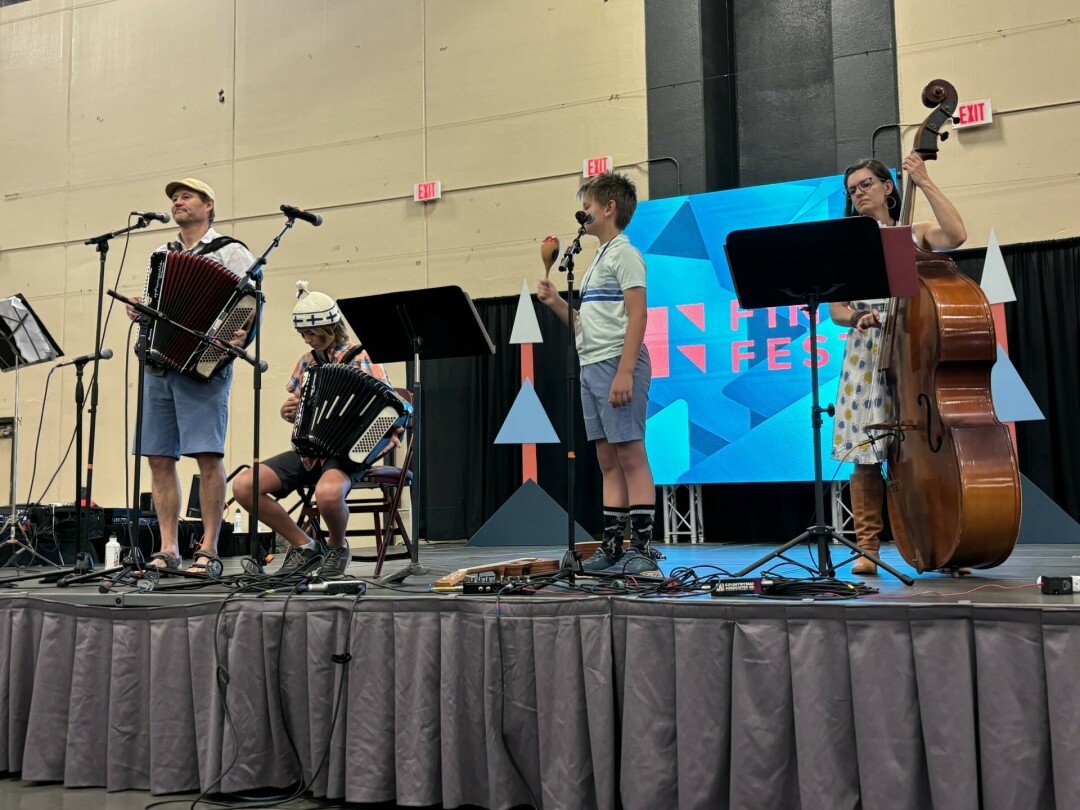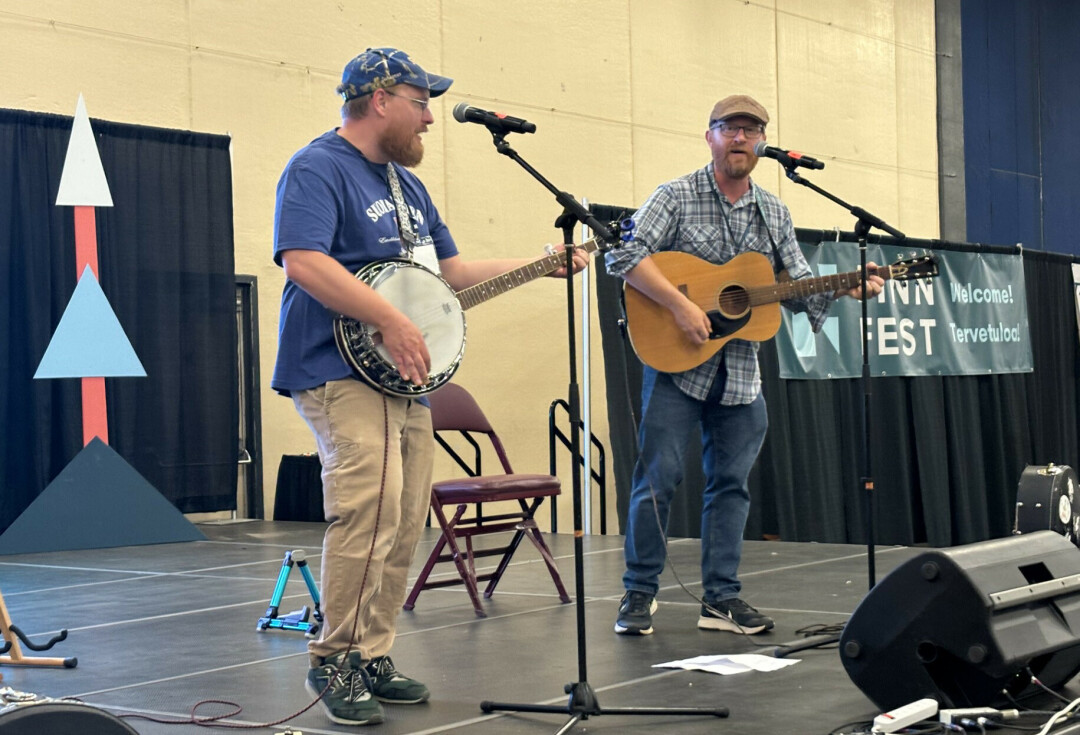This ain’t no rock and roll!

FinnFest dancers (Photos by Jill Fisher)
It was the FinnFest after all, so the vibe was pretty much all about the old country – Finland that is. And it involved so much more than just music.
The five-day gathering, the second annual one held in Duluth, covered a lot of Finnish ground – economics, politics, health practices, immigration and early U.S. settlement, environmental challenges and solutions, utopian visions, birding, food, traditional dancing, fashion design (vintage Marimekko and Kirsten Aune originals), ancestry research, writings, architecture, saunas and artisan crafts.
It even included Ojibwe themes with drumming sessions and presentations about birchbark wigwam construction and wild rice. A PBS-produced film about Finland as the “Happiest Country in the World” was both eye-opening and engaging, making me lament why our country can’t be more like Finland. Besides all this there was a national floorball tournament for the Troy Cup taking place in the Amsoil Arena. Floorball is like field hockey, but indoors. Something for everyone.
But since I was there to find out what Finnish music is all about I got started on the first day of the convention, Wednesday, July 24, by attending a presentation by Carl Rahkonen, “Finnish-American Composers of Art Music” This was primarily classical music by Finns who either visited or immigrated to the U.S. and their compositions, such as “The Queen of the Waves Waltz” by A. L. Klemi. Since the recording is available on YouTube (among others played) these numbers provided a taste of what that music was all about, even though it was recorded by a Swedish group with accordion, violin and saxophone. Rahkonen also brought to our attention a Finnish symphony in F Major that has never been performed.

Northern Stars Sami Girls
Midafternoon on the next day The Northern Stars Sami Girls, a trio comprised of Teresa Aho (accordion and vocals) and her daughters Terri Aho (fiddle and tambourine) and Kristiina Aho (bassoon and clarinet), played old timey Finnish-American numbers. These included waltzes, schottisches, polkas and tangos. It was complete immersion in the Finnish language since the lyrics of virtually all the numbers were in Finnish.
Now I speak some Norwegian, but that didn’t help me understand the language one bit, so no need to contemplate any “message,” rather it allowed me to just relax and enjoy the music. The tune, “I Stand High on the Mountainside” included a fine bassoon solo by Kristiina. How often do you get to hear that?
FinnFest officially opened on Thursday evening with a Convocation that began with a procession of 10 young Salolampi Village Campers singing and playing acoustic guitars. A drum ceremony by the Fond du Lac tribe of Ojibwe followed. It had hearts resonating with the pounding rhythms and concluded with the tinkling sound of the women’s “jingle dresses” which are said to aid healing.
Following that was a statement of acknowledgement that these proceedings were taking place on land once belonging to and occupied by indigenous people. Both Twin Ports mayors greeted and welcomed the attendees. Mayor Jim Paine acted as emcee for the gathering. A touching address by Arne Vainio, whose father was Finnish and mother was Anishinaabe, about keeping one’s heritage alive served to unite the proceedings. And then there was more music.

Sara Pajunen
A highlight of all the music at this festival was this evening’s performance by Sara Pajunen of “Metsākukkia” – an exquisite violin solo that almost made me cry it was so lovely. A quick change of mood followed with Teresa Aho and Carl Rahkonen playing a Finnish polka on accordion and fiddle, respectively. There was more of this latter music throughout the following three days.
Friday morning a Salolampi sing-along was scheduled for the “Tori” (marketplace) stage which showcased the music of Tiina Watts and Susan Harstad. Both played acoustic guitars, but few folks actually sang along. These two were quite delightful singing Finnish camp songs, along with other Finnish ballads. What struck me was how much the language, with the usual pronunciation of all the vowels, sounded like Hawaiian. That’s probably a stretch, but what can you expect from someone whose only second language is Norwegian?
Finnish dances demonstrated in the early afternoon that day, accompanied by a live band, had interesting names: jenkka (schottische), humpp, and mazurka. These accompanying bands included lute, ukelele, acoustic guitar, triangle and other small percussion instruments, along with the ever-present accordion. Thus much of the music I heard throughout the festival had a similar sound.

Majority Finn
Later that afternoon. Pasi Lautala and his family band, Majority Finn (formerly The Lautala Boys), took to the stage to provide more traditional Finnish music. Pasi played accordion and his wife, Meg Pachmayer, played stand-up bass, while Olavi, the older of their two young boys played acoustic guitar and a small accordion. The youngest, Ansel, contributed on ukelele and maracas. All except Meg sang as well. It was a fun set and one that reinforced the difference between such traditional music and rock and roll (but I liked it!).
Later on in the day the Finnish-American singer-songwriter Kyle Gray Young played covers of contemporary Finnish musicians. A session I hated to miss, due to scheduling conflicts, was one about Viola Turpeinen, a 2024 honoree in the Library of Congress Recording Registry for her 1928 “Kauhavan Polkka.” She was the first accordionist and first Finlander to be inducted.

Steve Solkela
By far the most engaging and hilarious musical performance of FinnFest had to be the “Dueling Accordions” that got Saturday off to a rambunctious start at 9 am. Pasi Lautala was joined by Duluth’s own Steve Solkela, a native of the Iron Range, who proved his Finnish background with articulated enunciations of these lyrics. The two accordionists went back and forth, good-naturedly trying to trip each other up with spontaneous key changes and challenging each other to play little-known songs.
Taking it to another level was a medley of polka tunes with constant key changes. Solkela’s deep bass vocals contrasted nicely with Pasi’s emotive tenor voice. One tune that had Solkela singing each verse faster and faster was absolutely nuts – even Pasi was amazed. He stated he could actually understand the words of the last (seventh!) verse. Solkela showed off some more with another tongue-twisting tune. But it was the banter between the two that had the crowd in stitches: Pasi noting that Solkela can play Finnish tunes “in some shape or form.”
Together they played Johnny Cash’s “I Walk The Line” with lyrics translated into Finnish. They also agreed that both were pissed off that the Finnish version of Steve Goodman’s “The City of New Orleans” had altered the original lyrics that pertain to a train, to those of a truck!

Lindula Brothers
Late Sunday morning saw me back at the DECC to hear the Lindula Brothers, who wrapped up FinnFest music in fine fashion. Well-known to local audiences, they were born and raised in Cherry, Minnesota. Brian, who now lives in Grand Rapids, plays five-string banjo while John, a resident of Duluth, plays acoustic guitar. This was blue ]grass music pretty much all the way, even when singing Finnish lyrics.
“Cornbread and Whiskey” with Brian leading in on banjo was a lively beginning to their set. They covered Steve Solkela’s “Sauna Song” and Gillian Welsh’s “Red Clay Halo,” which John said was a gospel number (sounded like bluegrass to me!). They interspersed several Finnish songs with other selections including an Irish tune, “Wild Mountain Thyme,” “Iron Range Rapsidy” by Solkela, a cover of Dylan’s “Shelter from the Storm” and Charlie Parr’s “Over the Red Cedar.”
And as testament to their Finnish background they preceded Woody Guthrie’s “Union Maid” with a statement that their father, grandfather and uncles were all union men. They said they are both teachers who have chosen to be members of the teachers’ union, “because that’s what’s best for everyone.”
It was a fascinating and educational five days that came our way. I was glad I chose to participate and encourage others to do so next year when FinnFest returns to Duluth!